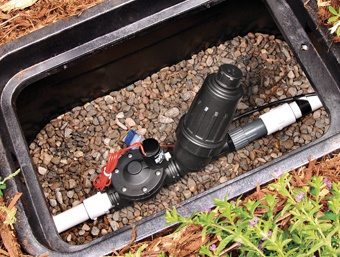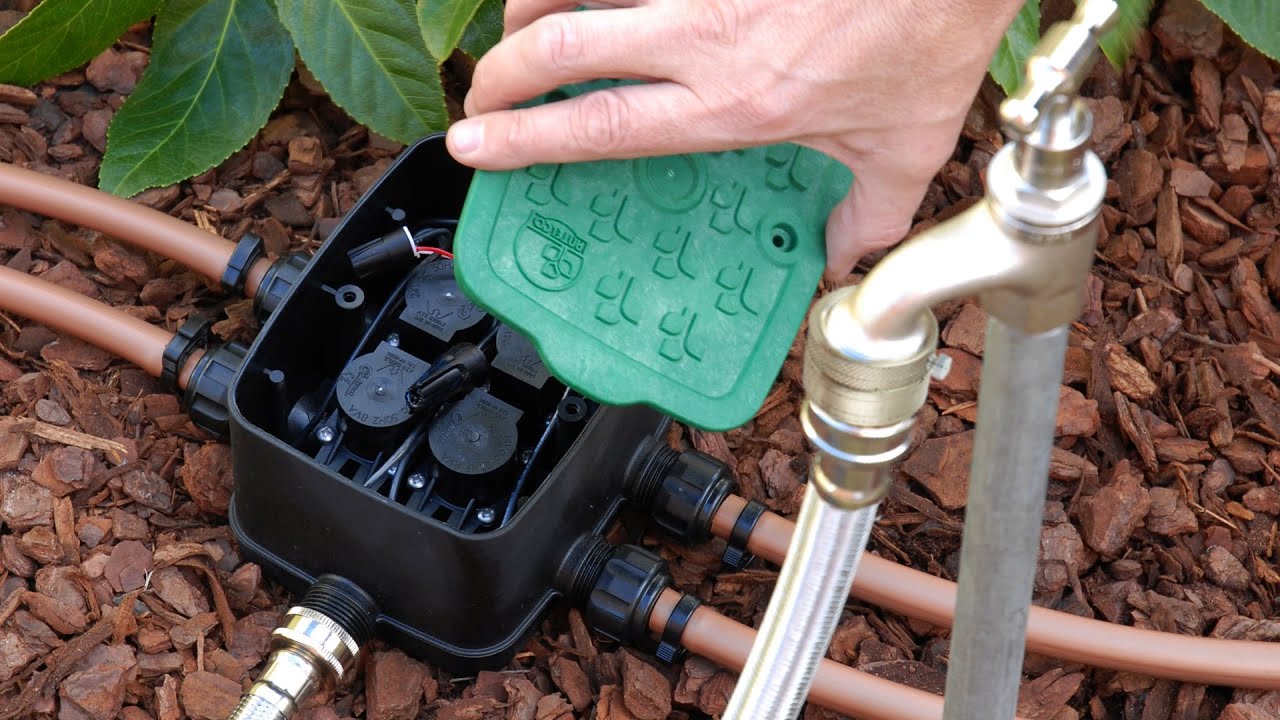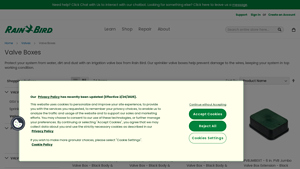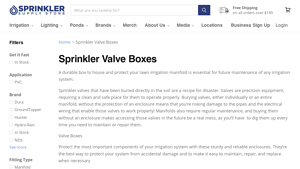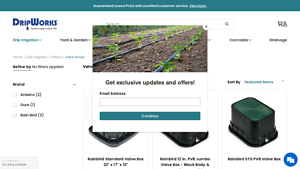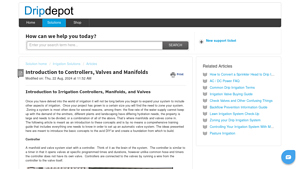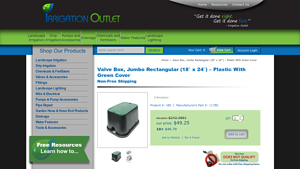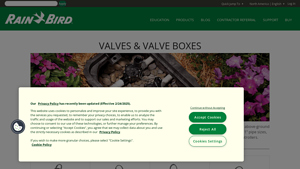Introduction: Navigating the Global Market for drip irrigation valve box
In the dynamic landscape of global agriculture, sourcing high-quality drip irrigation valve boxes can be a daunting challenge for B2B buyers. These essential components serve not only to protect irrigation systems from environmental hazards but also to facilitate ease of maintenance, ensuring optimal functionality. As international markets expand, particularly in regions like Africa, South America, the Middle East, and Europe, understanding the nuances of valve box specifications and applications becomes critical.
This comprehensive guide delves into various types of drip irrigation valve boxes, their applications across diverse agricultural settings, and essential factors for supplier vetting. From assessing material durability to evaluating cost-effectiveness, we provide actionable insights that enable informed purchasing decisions. Additionally, we address common challenges faced by buyers, such as identifying reputable suppliers and understanding regional compliance standards.
By equipping B2B buyers with the knowledge necessary to navigate this market, this guide empowers stakeholders to enhance their irrigation systems, optimize resource management, and ultimately drive agricultural productivity. Whether you’re operating in Nigeria, Vietnam, or elsewhere, our focus is on delivering the information you need to secure reliable, cost-efficient solutions tailored to your specific irrigation needs.
Understanding drip irrigation valve box Types and Variations
| Type Name | Key Distinguishing Features | Primary B2B Applications | Brief Pros & Cons for Buyers |
|---|---|---|---|
| Standard Valve Box | Basic design, usually rectangular or round, for single or multiple valves | Residential and small commercial irrigation | Pros: Cost-effective, easy to install. Cons: Limited capacity for larger systems. |
| Jumbo Valve Box | Larger size to accommodate multiple valves and fittings | Large-scale agricultural and commercial setups | Pros: Ample space for maintenance, durable. Cons: Higher upfront cost. |
| Lockable Valve Box | Security features to prevent unauthorized access | High-security installations, public spaces | Pros: Enhanced security, protects equipment. Cons: More expensive, may require keys. |
| Extension Valve Box | Designed to extend existing valve boxes for added capacity | Growing irrigation systems | Pros: Flexible design, cost-effective expansion. Cons: Requires additional installation work. |
| Waterproof Valve Box | Sealed design to prevent water ingress | Areas prone to flooding or high moisture | Pros: Protects valves from damage, ensures longevity. Cons: Higher cost, may require specific installation. |
What Are the Characteristics of Standard Valve Boxes?
Standard valve boxes are the most commonly used type in drip irrigation systems. Typically rectangular or round, they provide sufficient space for one or multiple valves. Their simplicity makes them suitable for residential and small commercial applications, where cost-effectiveness is crucial. Buyers should consider the size of their irrigation system when selecting a standard valve box, as a mismatch can lead to difficulties during maintenance.
How Do Jumbo Valve Boxes Support Large-Scale Operations?
Jumbo valve boxes are designed for larger irrigation systems, providing ample space for multiple valves and fittings. Their robust construction makes them ideal for agricultural and large commercial setups, where durability and accessibility are critical. When purchasing, B2B buyers should evaluate the expected number of valves and the box’s dimensions to ensure optimal performance and maintenance ease.
Why Choose Lockable Valve Boxes for Security?
Lockable valve boxes are equipped with security features to prevent unauthorized access, making them suitable for high-security installations such as public parks or commercial properties. These boxes help protect expensive irrigation equipment from theft or vandalism. Buyers should weigh the added security benefits against the higher costs, as well as consider the potential need for key management.
What Advantages Do Extension Valve Boxes Offer?
Extension valve boxes are specifically designed to increase the capacity of existing valve boxes, making them an excellent choice for growing irrigation systems. They allow for the easy addition of more valves without the need for complete system overhaul, which can be cost-effective. Buyers should consider the compatibility with their current systems and the potential for future expansion when selecting extension boxes.
How Do Waterproof Valve Boxes Enhance Longevity?
Waterproof valve boxes feature a sealed design that prevents water ingress, making them ideal for regions prone to flooding or high moisture. This protection extends the life of the valves and the overall irrigation system. While these boxes typically come at a higher price point, the investment can lead to significant savings in repairs and replacements over time. B2B buyers should assess their environmental conditions when considering waterproof options.
Key Industrial Applications of drip irrigation valve box
| Industry/Sector | Specific Application of drip irrigation valve box | Value/Benefit for the Business | Key Sourcing Considerations for this Application |
|---|---|---|---|
| Agriculture | Managing irrigation systems in large-scale farms | Ensures efficient water use, reducing costs and increasing yield | Durability, size compatibility, and ease of access for maintenance |
| Landscaping | Supporting commercial landscaping irrigation systems | Protects valves from environmental damage, enhancing longevity | Weather resistance, aesthetic design, and lockable options |
| Horticulture | Facilitating precise water delivery in nurseries and greenhouses | Promotes optimal plant growth and resource conservation | Custom sizing, compatibility with various valve types |
| Municipal Water Supply | Regulating water distribution in public parks and green spaces | Improves water management efficiency and reduces waste | Compliance with local regulations and robust construction materials |
| Golf Courses | Maintaining irrigation systems for fairways and greens | Enhances turf health and reduces operational costs | High durability and resistance to wear from heavy machinery |
How is the Drip Irrigation Valve Box Used in Agriculture?
In large-scale farming, drip irrigation valve boxes play a crucial role in managing water distribution. They protect the valves from dirt, moisture, and damage, ensuring consistent water delivery to crops. This is particularly important in regions with varying climates, such as Africa and South America, where efficient water use can significantly impact yield. Buyers in this sector should prioritize durability and size compatibility to accommodate multiple valves, facilitating easy maintenance and repairs.
What are the Applications in Landscaping?
For commercial landscaping projects, drip irrigation valve boxes safeguard the integrity of irrigation systems. They prevent environmental damage to the valves, extending their lifespan and ensuring optimal performance. This is essential in regions with harsh weather conditions, such as the Middle East, where heat and dust can lead to rapid deterioration. Buyers should consider weather-resistant materials and aesthetically pleasing designs that blend with landscaping features while also ensuring easy access for maintenance.
Why is it Important in Horticulture?
In horticulture, particularly in nurseries and greenhouses, drip irrigation valve boxes enable precise water delivery, crucial for promoting healthy plant growth. They help manage water resources effectively, which is vital in regions facing water scarcity. Buyers should focus on custom sizing to fit various valve types and ensure compatibility with existing irrigation systems, enhancing overall efficiency and sustainability in their operations.
How Does it Benefit Municipal Water Supply Systems?
Municipal water supply systems utilize drip irrigation valve boxes to regulate water distribution in public parks and green spaces. This application improves water management efficiency and minimizes waste, which is increasingly important in urban planning across Europe and other regions. When sourcing, municipalities must ensure compliance with local regulations and choose robust construction materials that withstand public use and environmental factors.
What Role Does it Play in Golf Course Maintenance?
Golf courses rely on drip irrigation valve boxes to maintain their irrigation systems, ensuring the health of fairways and greens. Efficient water management not only enhances turf quality but also reduces operational costs, which is critical in the competitive golf industry. Buyers should seek valve boxes with high durability and resistance to wear from maintenance machinery, ensuring long-term functionality and reliability in their irrigation systems.
3 Common User Pain Points for ‘drip irrigation valve box’ & Their Solutions
Scenario 1: Difficulty in Maintaining Valve Access
The Problem: In many irrigation systems, particularly in regions with challenging climates like parts of Africa and the Middle East, access to valves can become a significant issue. Valve boxes that are too small or poorly placed can make maintenance cumbersome, requiring extensive digging and potentially damaging the surrounding landscape. This scenario can lead to increased labor costs, downtime, and frustration for agricultural businesses or landscaping companies that depend on efficient irrigation systems.
The Solution: To address this challenge, B2B buyers should prioritize selecting appropriately sized valve boxes that provide ample space for maintenance. When sourcing drip irrigation valve boxes, consider purchasing models designed for multiple valves, which can streamline access and reduce the need for extensive digging. It’s also advisable to install valve boxes flush with the ground level, ensuring they are easily accessible while protecting the valves from debris and damage. Additionally, opting for valve boxes with removable tops or built-in pipe slots can facilitate quicker maintenance checks, ultimately saving time and reducing labor costs.
Scenario 2: Risk of Water Infiltration and Damage
The Problem: Water accumulation within valve boxes is a common issue that can lead to valve malfunction and extensive system damage. This problem is particularly pronounced in areas with high rainfall or poor drainage, such as in some South American regions. Accumulated water can cause corrosion of the valves and electrical components, leading to costly repairs and operational downtime.
The Solution: B2B buyers should look for drip irrigation valve boxes with built-in drainage features or those made from materials resistant to corrosion. When specifying these valve boxes, ensure they have proper sealing mechanisms to prevent water infiltration while still allowing for adequate drainage. In addition, consider the installation location carefully—elevating the valve box slightly above the surrounding ground level can help mitigate water accumulation. Regular inspections and maintenance should also be scheduled to ensure that any drainage systems are functioning correctly and that the valve boxes remain dry.
Scenario 3: Complications in System Expansion
The Problem: As agricultural operations grow or change, existing irrigation systems may require expansion or modification. B2B buyers often face difficulties in integrating new valves into their existing setups, especially when the current valve boxes are not designed to accommodate additional components. This can lead to inefficiencies and increased costs, particularly in regions experiencing rapid agricultural development, like parts of Vietnam.
The Solution: To effectively manage system expansions, it’s crucial for buyers to invest in modular drip irrigation valve boxes that can accommodate additional valves and components without requiring complete system overhauls. When purchasing, consider valve boxes that allow for easy customization and modification. Ensure that the boxes are compatible with standard valve sizes and can be easily integrated with existing systems. Additionally, utilizing a professional irrigation consultant can help assess current setups and identify the best solutions for future expansions, ensuring that the irrigation system remains efficient and cost-effective as needs evolve.
Strategic Material Selection Guide for drip irrigation valve box
When selecting materials for drip irrigation valve boxes, it is essential to consider various factors that influence performance, durability, and cost-effectiveness. Here, we analyze four common materials used in the manufacturing of these components, focusing on their properties, advantages, disadvantages, and implications for international B2B buyers.
What are the Key Properties of Polypropylene in Drip Irrigation Valve Boxes?
Polypropylene (PP) is a thermoplastic polymer known for its excellent chemical resistance and lightweight nature. It typically withstands temperatures ranging from -20°C to 100°C, making it suitable for various climates. Its corrosion resistance ensures longevity, particularly in environments where exposure to fertilizers or chemicals is common.
Pros: Polypropylene is cost-effective and easy to manufacture, allowing for high-volume production. Its lightweight nature simplifies installation and reduces shipping costs.
Cons: While durable, polypropylene can become brittle over time when exposed to UV light unless treated. It may also not withstand extreme temperatures as well as some other materials.
Impact on Application: Polypropylene is compatible with a wide range of irrigation media, including water and fertilizers, making it a versatile choice for various agricultural applications.
Considerations for International Buyers: Compliance with local standards (such as ASTM or DIN) is crucial. Buyers in regions like Africa and South America should ensure that the product meets their specific environmental conditions, particularly concerning UV exposure.
How Does PVC Compare for Drip Irrigation Valve Boxes?
Polyvinyl Chloride (PVC) is another popular choice for valve boxes due to its high strength and rigidity. PVC can handle temperatures up to 60°C and is highly resistant to corrosion and chemicals, making it ideal for agricultural applications.
Pros: PVC is highly durable and resistant to environmental stressors, ensuring a long lifespan. It is also readily available and relatively inexpensive.
Cons: The rigidity of PVC can make it less adaptable in certain installations, and it may require additional fittings for connections. Additionally, its production involves more complex processes compared to polypropylene.
Impact on Application: PVC is suitable for various irrigation media, including potable water, making it a reliable choice for diverse applications.
Considerations for International Buyers: Buyers should verify that PVC products comply with relevant standards in their regions, such as JIS in Japan or EN in Europe, to ensure safety and effectiveness.
What are the Benefits and Limitations of Metal Valve Boxes?
Metal valve boxes, often made from galvanized steel or aluminum, provide exceptional strength and durability. They can withstand extreme temperatures and pressures, making them suitable for high-demand applications.
Pros: Metal boxes are incredibly durable and can handle significant wear and tear, making them ideal for heavy-duty use. They also offer excellent protection against physical damage.
Cons: Metal boxes can be more expensive than plastic alternatives and may require additional coatings to prevent corrosion. They are also heavier, which can increase shipping and installation costs.
Impact on Application: Metal valve boxes are ideal for applications where physical protection is paramount, such as in industrial settings or areas with heavy machinery.
Considerations for International Buyers: Buyers must ensure that metal products comply with local corrosion resistance standards, particularly in humid or saline environments common in regions like the Middle East.
How Do Composite Materials Enhance Drip Irrigation Valve Boxes?
Composite materials, typically a blend of plastics and other materials, offer enhanced properties, such as improved strength and UV resistance. They can withstand a wide range of temperatures, often exceeding 100°C.
Pros: Composites are lightweight yet strong, providing excellent durability and resistance to environmental factors. They can also be manufactured to meet specific performance criteria.
Cons: The manufacturing process for composites can be more complex and costly, which may reflect in the final product price. Additionally, not all composites are recyclable, raising environmental concerns.
Impact on Application: Composite boxes can be tailored for specific irrigation media, including aggressive chemicals, making them suitable for specialized applications.
Considerations for International Buyers: Buyers should look for certifications that confirm the composite’s performance under local conditions, particularly in regions with extreme weather patterns.
Summary Table of Material Selection for Drip Irrigation Valve Boxes
| Material | Typical Use Case for drip irrigation valve box | Key Advantage | Key Disadvantage/Limitation | Relative Cost (Low/Med/High) |
|---|---|---|---|---|
| Polypropylene | General irrigation applications | Cost-effective and lightweight | UV sensitivity without treatment | Low |
| Polyvinyl Chloride (PVC) | Potable water and agricultural use | Durable and corrosion-resistant | Rigid, may require additional fittings | Medium |
| Metal | Heavy-duty industrial applications | Exceptional strength and durability | Higher cost and potential corrosion | High |
| Composite | Specialized applications with aggressive media | Tailored performance and UV resistance | Complex manufacturing process | Medium to High |
This analysis provides a comprehensive overview of the materials available for drip irrigation valve boxes, helping international B2B buyers make informed decisions based on their specific needs and regional conditions.
In-depth Look: Manufacturing Processes and Quality Assurance for drip irrigation valve box
What Are the Key Stages in the Manufacturing Process of Drip Irrigation Valve Boxes?
The manufacturing of drip irrigation valve boxes involves several crucial stages, each contributing to the overall quality and functionality of the final product. The main processes include material preparation, forming, assembly, and finishing.
How Is Material Prepared for Drip Irrigation Valve Boxes?
Material preparation is the first step in the manufacturing process. Typically, high-density polyethylene (HDPE) or polypropylene is used due to their durability and resistance to UV rays and chemicals. The raw materials undergo a thorough inspection to ensure they meet the required specifications. This includes checking for impurities, color consistency, and physical properties.
Once the materials are approved, they are cut into the necessary dimensions for the valve boxes. Advanced techniques such as extrusion or injection molding are often employed to create the initial shapes, ensuring a precise fit for valves and associated components.
What Forming Techniques Are Commonly Used in Valve Box Production?
The forming stage utilizes techniques like injection molding or rotational molding, depending on the design and volume requirements. Injection molding is favored for its efficiency and ability to produce complex shapes with high accuracy. In contrast, rotational molding is often used for larger, hollow components.
During this stage, molds are created that reflect the final design specifications. Quality control measures are implemented to monitor the temperature, pressure, and timing during the forming process, ensuring that the material is properly melted and shaped without defects.
How Is the Assembly Process Conducted for Drip Irrigation Valve Boxes?
Assembly is a critical phase where various components, such as the body, lid, and any internal fittings, are brought together. This process may involve mechanical fastening, welding, or adhesive bonding. Quality assurance checks are conducted at this stage to ensure that all parts fit correctly and function as intended.
Special attention is paid to the sealing mechanisms, which are vital for preventing water ingress. Manufacturers often utilize gaskets or O-rings made from materials resistant to weathering and chemical exposure to enhance durability.
What Finishing Processes Are Applied to Ensure Quality and Durability?
Finishing processes include surface treatments and coatings that enhance the aesthetic appeal and functionality of the valve boxes. Techniques such as UV-resistant coatings, painting, or texturing are commonly employed to improve weather resistance and camouflage the boxes within landscaping.
Furthermore, each finished product undergoes a visual inspection for surface defects, color uniformity, and overall appearance. Additional treatments, such as anti-static coatings, may be applied to prevent dust accumulation, which is particularly important in arid regions.
How Are Quality Control Measures Implemented in the Manufacturing of Valve Boxes?
Quality control (QC) is integral to the manufacturing process of drip irrigation valve boxes, ensuring that products meet international standards and customer expectations. This involves adherence to international quality standards such as ISO 9001, which focuses on maintaining quality management systems.
What Are the Key International Standards Relevant to Valve Box Manufacturing?
ISO 9001 provides a framework for consistent quality and reliability across production processes. Additionally, industry-specific certifications such as CE marking (indicating compliance with EU safety standards) and API (American Petroleum Institute) standards may also be relevant, depending on the application of the valve boxes.
B2B buyers should consider these certifications as indicators of quality assurance, especially when sourcing from international suppliers. Compliance with these standards not only assures product safety but also enhances the credibility of the supplier in the global marketplace.
What Are the Common QC Checkpoints in the Manufacturing Process?
Quality control checkpoints are established at various stages of production to monitor compliance and identify defects. These typically include:
Incoming Quality Control (IQC): This involves inspecting raw materials upon arrival to ensure they meet specified standards before production begins.
In-Process Quality Control (IPQC): Throughout the manufacturing stages, regular checks are conducted to monitor the production process. This includes assessing the accuracy of forming techniques and the integrity of assembly.
Final Quality Control (FQC): Once the valve boxes are fully assembled, they undergo comprehensive testing. This includes checking dimensions, testing for water resistance, and ensuring that all components function correctly.
How Can B2B Buyers Verify Supplier Quality Control Practices?
For B2B buyers, especially those in regions like Africa, South America, the Middle East, and Europe, verifying supplier quality control practices is crucial for ensuring product reliability. Here are several actionable steps:
What Audit Processes Should B2B Buyers Consider?
Conducting audits of potential suppliers is one of the most effective ways to verify their quality control processes. Buyers should request to see documentation related to their ISO certifications, quality management systems, and any third-party audits they may have undergone.
Furthermore, prospective buyers can request to visit manufacturing facilities to observe processes firsthand. This not only allows buyers to assess quality control practices but also helps establish a relationship with the supplier.
How Can Buyers Utilize Testing Reports and Third-Party Inspections?
Buyers should request detailed testing reports that outline the results of various quality assessments conducted on the products. These reports should include data from mechanical tests, environmental simulations, and any compliance testing with relevant standards.
Engaging third-party inspection services can also provide an unbiased assessment of the manufacturer’s quality assurance practices. These services can conduct random sampling inspections and provide detailed reports to buyers, ensuring transparency and reliability.
What Are the QC and Certification Nuances for International B2B Buyers?
When sourcing from international suppliers, especially in diverse markets, buyers must be aware of the nuances in quality control and certification processes. Different countries may have varying regulations and standards, which can impact the quality and compliance of the products being sourced.
For instance, products sold in the European market must comply with CE marking requirements, while products in the U.S. might need to meet specific ANSI or ASTM standards. Understanding these requirements is crucial for avoiding potential compliance issues and ensuring that the products meet local regulations.
B2B buyers should also consider the supply chain logistics that may affect product quality. Delays or mishandling during transportation can lead to defects, so it’s important to work with suppliers who have robust logistics and handling procedures in place.
Conclusion
In summary, the manufacturing processes and quality assurance measures for drip irrigation valve boxes play a significant role in ensuring product reliability and performance. By understanding the key stages of manufacturing, relevant quality control standards, and how to verify supplier practices, B2B buyers can make informed decisions when sourcing these essential components for their irrigation systems.
Practical Sourcing Guide: A Step-by-Step Checklist for ‘drip irrigation valve box’
In the competitive landscape of irrigation solutions, sourcing the right drip irrigation valve box is essential for ensuring efficient and reliable water management systems. This guide provides a comprehensive checklist to assist B2B buyers in making informed decisions when procuring valve boxes for their irrigation projects.
Step 1: Define Your Technical Specifications
Before initiating the procurement process, it’s vital to outline the technical specifications required for your drip irrigation valve box. Consider factors such as the size, material, and design. For example, a box must accommodate the number of valves you plan to install and be made from durable materials that can withstand environmental conditions in your region.
- Consider the material: Look for options that resist corrosion and UV damage, ensuring longevity.
- Assess size requirements: Ensure the dimensions fit your installation needs, allowing for easy access and maintenance.
Step 2: Research Reputable Suppliers
Finding a trustworthy supplier is crucial for obtaining high-quality products. Investigate suppliers who specialize in irrigation components and have a solid reputation in the market. Check online reviews and ratings, and consider reaching out to existing customers for their experiences.
- Evaluate their product range: A diverse selection of valve boxes indicates a supplier’s expertise.
- Look for industry experience: Suppliers with a long-standing presence in the market are often more reliable.
Step 3: Verify Supplier Certifications
Ensure that the suppliers you are considering hold relevant certifications and comply with international standards. Certifications can serve as indicators of quality and reliability, essential for maintaining the integrity of your irrigation system.
- Check for ISO certifications: This reflects a commitment to quality management.
- Look for local regulatory compliance: Different regions may have specific standards that need to be met.
Step 4: Request Samples or Prototypes
Before placing a bulk order, request samples or prototypes of the valve boxes. This allows you to assess the product quality and compatibility with your existing systems. Testing samples can also help identify any potential issues early in the process.
- Conduct field tests: Install the sample in a controlled environment to evaluate performance.
- Assess ease of installation: Ensure that the design facilitates straightforward setup and maintenance.
Step 5: Compare Pricing and Terms
Once you have identified potential suppliers and verified their credentials, compare pricing structures and payment terms. While cost is important, consider the overall value, including warranty offerings and after-sales support.
- Evaluate bulk order discounts: Many suppliers offer reduced rates for larger orders, which can significantly lower costs.
- Review payment options: Flexible terms can improve cash flow and facilitate budgeting for your project.
Step 6: Evaluate Customer Support and Service
Strong customer support can make a significant difference in your procurement experience. Assess the responsiveness and availability of the supplier’s customer service team, as this can impact your ability to resolve issues quickly.
- Inquire about support channels: Ensure they offer multiple ways to get in touch, such as phone, email, and live chat.
- Check warranty and return policies: Understanding these policies can help you mitigate risks associated with defective products.
Step 7: Finalize the Purchase Agreement
Once you’ve completed your evaluation and are satisfied with your chosen supplier, proceed to finalize the purchase agreement. Ensure all terms discussed are documented, including delivery timelines, pricing, and warranties.
- Detail the payment schedule: Clearly outline when payments are due and any penalties for late payments.
- Confirm delivery logistics: Establish who is responsible for shipping and any associated costs to avoid misunderstandings.
By following this structured checklist, B2B buyers can confidently navigate the procurement process for drip irrigation valve boxes, ensuring they select the right products for their irrigation systems.
Comprehensive Cost and Pricing Analysis for drip irrigation valve box Sourcing
What are the Key Cost Components for Drip Irrigation Valve Boxes?
When sourcing drip irrigation valve boxes, it is essential to understand the various cost components that contribute to the final pricing. Key elements include:
Materials: The choice of materials significantly affects pricing. Common materials for valve boxes include high-density polyethylene (HDPE) and polypropylene, which offer durability against environmental factors. The quality and source of these materials can vary, impacting the overall cost.
Labor: Labor costs involve the workforce required for production. This includes both skilled and unskilled labor, with wages varying significantly across regions, particularly between developing markets in Africa and South America and more developed regions like Europe.
Manufacturing Overhead: This includes expenses related to the production process, such as utilities, facility maintenance, and indirect labor costs. Efficient production processes can help minimize these overheads.
Tooling: Initial tooling costs can be substantial, especially for customized valve boxes. Investments in molds and machinery are crucial for producing unique designs, which can increase the upfront costs but allow for more tailored solutions.
Quality Control (QC): Ensuring that the valve boxes meet specified quality standards requires a robust QC process. This may involve testing for durability, water resistance, and compliance with local regulations, adding to the overall cost.
Logistics: Shipping and handling costs are critical, particularly for international buyers. Factors such as distance, transportation mode, and local tariffs can influence logistics costs significantly.
Margin: Suppliers will typically add a profit margin to cover their operational costs and desired profit. Understanding the standard margins in your target market can help in negotiating better deals.
How Do Price Influencers Affect Drip Irrigation Valve Box Costs?
Several factors can influence the pricing of drip irrigation valve boxes, including:
Volume/MOQ: Larger orders often qualify for discounts due to economies of scale. Understanding the minimum order quantities (MOQs) can help in negotiating better pricing.
Specifications and Customization: Customized designs or specific features can lead to higher prices due to the added complexity in production. Buyers should weigh the benefits of customization against the potential cost increases.
Materials: The quality of materials directly influences pricing. High-quality, certified materials may cost more upfront but can lead to lower maintenance costs over time.
Quality and Certifications: Products that come with certifications (such as ISO or CE) often command higher prices due to the assurance of quality and compliance with safety standards.
Supplier Factors: Supplier reputation, reliability, and location can also affect pricing. Established suppliers may charge a premium, but they often offer better service and quality assurance.
Incoterms: Understanding international commercial terms (Incoterms) is crucial for international buyers. They define the responsibilities of buyers and sellers in shipping, impacting overall costs.
What Buyer Tips Can Help Negotiate Better Prices for Drip Irrigation Valve Boxes?
For international B2B buyers, especially those from regions like Africa, South America, the Middle East, and Europe, several strategies can enhance cost-efficiency:
Negotiation: Engage in open discussions with suppliers about pricing. Highlight your purchasing power and potential for long-term partnerships to secure better deals.
Cost-Efficiency: Assess the Total Cost of Ownership (TCO), which includes not just the purchase price but also installation, maintenance, and potential downtime costs. This holistic view can guide better purchasing decisions.
Pricing Nuances: Be aware of seasonal price fluctuations and market trends in the irrigation industry. Timing your purchases can lead to significant savings.
Research and Compare: Conduct thorough research on multiple suppliers to compare prices and offerings. This not only provides insight into market standards but also strengthens your negotiating position.
In conclusion, understanding the comprehensive cost structure and pricing influencers of drip irrigation valve boxes can empower buyers to make informed decisions, ultimately leading to better procurement strategies tailored to their specific needs and markets.
Alternatives Analysis: Comparing drip irrigation valve box With Other Solutions
Exploring Alternatives to Drip Irrigation Valve Boxes
In the realm of irrigation systems, particularly in regions with variable climates such as Africa, South America, the Middle East, and Europe, selecting the right components is crucial for efficiency and sustainability. While drip irrigation valve boxes serve as a robust solution for managing water distribution, there are alternative methods and technologies that can also meet irrigation needs. This section compares the drip irrigation valve box against two viable alternatives: sprinkler systems and surface irrigation.
| Comparison Aspect | Drip Irrigation Valve Box | Sprinkler System | Surface Irrigation |
|---|---|---|---|
| Performance | Highly efficient for targeted watering; reduces evaporation and runoff. | Covers large areas quickly; best for lawns and large crops. | Effective for flat terrains; relies on gravity for water distribution. |
| Cost | Moderate initial cost; long-term savings on water usage. | Higher initial setup costs; requires more maintenance. | Low initial costs; potential for high water wastage. |
| Ease of Implementation | Requires careful planning and installation; can be complex. | Easier to install for large areas; requires less technical knowledge. | Simple to implement; minimal equipment needed. |
| Maintenance | Low maintenance; occasional checks required. | Moderate maintenance; heads may clog or require adjustments. | High maintenance; needs regular checks to prevent waterlogging. |
| Best Use Case | Ideal for gardens, greenhouses, and orchards with varied plant needs. | Best for open fields and lawns needing uniform coverage. | Suitable for crops in flat regions with adequate water supply. |
Analyzing the Alternatives: Pros and Cons
Sprinkler Systems
Sprinkler systems are a popular alternative that delivers water over a large area, making them suitable for lawns, gardens, and agricultural fields. Their primary advantage is the speed at which they can cover expansive areas, providing uniform coverage. However, they can lead to water wastage through evaporation and runoff, especially in windy conditions. Additionally, the initial installation costs can be significantly higher, and maintaining the system requires regular checks and cleaning of sprinkler heads.
Surface Irrigation
Surface irrigation, often considered the simplest method, involves distributing water over the soil surface, relying on gravity to move water through the field. This method is particularly effective in flat terrains and can be very cost-effective due to low initial setup costs. However, it has significant drawbacks, including the potential for high water wastage and uneven distribution, which can lead to waterlogging in certain areas. Maintenance is also more intensive, as farmers must regularly check for issues like sediment buildup and ensure the channels remain clear.
Conclusion: Making the Right Choice for Your Irrigation Needs
Choosing the right irrigation solution depends on various factors, including the specific agricultural practices, terrain, and water availability in your region. A drip irrigation valve box offers precision and efficiency, making it a top choice for diverse planting needs. In contrast, sprinkler systems excel in covering larger areas quickly but may incur higher costs and water wastage. Surface irrigation, while economical, may not be suitable for all crops due to its reliance on gravity and potential for uneven water distribution. B2B buyers should evaluate their unique requirements, considering performance, cost, and maintenance, to make an informed decision that aligns with their operational goals.
Essential Technical Properties and Trade Terminology for drip irrigation valve box
What Are the Key Technical Properties of Drip Irrigation Valve Boxes?
1. Material Grade
Drip irrigation valve boxes are commonly made from high-density polyethylene (HDPE) or polypropylene. These materials offer excellent durability, resistance to UV radiation, and protection against chemical exposure. The choice of material is critical for B2B buyers as it directly impacts the longevity and reliability of the irrigation system, particularly in harsh climates often encountered in regions like Africa and the Middle East.
2. Size and Dimensions
The dimensions of the valve box are essential for accommodating the number of valves and fittings required for an irrigation system. Common sizes range from 6 to 12 inches in diameter, with various heights. Selecting the right size ensures easy access for maintenance and repair, minimizing the need for extensive excavation, which can be both time-consuming and costly.
3. Load Capacity
The load capacity of a valve box indicates how much weight it can bear without deformation or failure. This is particularly important for installations in areas with heavy foot traffic or vehicular access. Understanding the load specifications helps B2B buyers choose the right product to avoid premature wear and potential system failures.
4. Waterproof and Dustproof Features
A robust valve box should possess waterproof and dustproof properties to protect the internal components from environmental elements. These features are crucial for preventing valve corrosion and ensuring consistent performance. Buyers should assess the sealing mechanisms and design features that enhance these protective qualities.
5. Access Design
Valve boxes often come with removable lids and built-in pipe slots for easy access to valves and connections. This design feature is vital for efficient maintenance and repairs, allowing for quick interventions without the need for extensive digging. B2B buyers should prioritize valve boxes that facilitate straightforward access, reducing downtime and operational disruptions.
What Are Common Trade Terms Related to Drip Irrigation Valve Boxes?
1. OEM (Original Equipment Manufacturer)
OEM refers to companies that produce parts or equipment that may be marketed by another manufacturer. In the context of drip irrigation, understanding OEM relationships helps buyers identify reliable suppliers who adhere to specific quality standards.
2. MOQ (Minimum Order Quantity)
MOQ is the minimum number of units a buyer must purchase from a supplier. This term is essential for B2B buyers as it can impact inventory management and cash flow. Knowing the MOQ helps buyers plan their purchases according to their project needs and budget constraints.
3. RFQ (Request for Quotation)
An RFQ is a formal request to suppliers for pricing information on specific products. This process allows buyers to compare costs and terms from multiple vendors, ensuring they receive the best value for their investment in drip irrigation systems.
4. Incoterms (International Commercial Terms)
Incoterms are standardized trade terms that define the responsibilities of buyers and sellers in international transactions. Understanding these terms is crucial for B2B buyers to clarify shipping, insurance, and delivery responsibilities, thereby minimizing potential disputes.
5. Lead Time
Lead time refers to the period between placing an order and receiving the product. For B2B buyers, understanding lead times is vital for project planning and ensuring that irrigation systems are installed and operational when needed.
6. Warranty and Guarantee
Warranties and guarantees provide assurance regarding the quality and durability of products. B2B buyers should carefully review these terms to protect their investment and ensure they have recourse in case of product defects or failures.
By understanding these technical properties and trade terminology, B2B buyers can make informed decisions that enhance the efficiency and effectiveness of their drip irrigation systems.
Navigating Market Dynamics and Sourcing Trends in the drip irrigation valve box Sector
What Are the Current Market Dynamics and Key Trends in the Drip Irrigation Valve Box Sector?
The drip irrigation valve box market is witnessing significant growth, driven by the increasing global demand for efficient water management solutions. Internationally, regions like Africa, South America, the Middle East, and Europe are prioritizing sustainable agricultural practices. This trend is propelled by factors such as climate change, water scarcity, and the need for food security. As governments and NGOs invest in irrigation infrastructure, the demand for high-quality valve boxes that protect system components from environmental elements is on the rise.
Emerging technologies are also shaping sourcing strategies. The integration of IoT (Internet of Things) into irrigation systems allows for real-time monitoring and management, enhancing efficiency. B2B buyers are increasingly looking for valve boxes that accommodate smart irrigation solutions. Moreover, advancements in materials science have led to the development of more durable and weather-resistant valve boxes, which are critical for maintaining system integrity in diverse climates.
Additionally, competitive pricing and value-added services, such as technical support and installation guidance, are becoming important criteria for B2B buyers. With a focus on long-term partnerships, suppliers who offer comprehensive service packages and customized solutions are likely to gain a competitive edge in this evolving market.
How Is Sustainability and Ethical Sourcing Impacting the Drip Irrigation Valve Box Market?
Sustainability has become a cornerstone of the drip irrigation valve box sector. Buyers are increasingly conscious of the environmental impact of their purchases, leading to a demand for products made from recycled or eco-friendly materials. Valve boxes manufactured from sustainable plastics or composites not only reduce waste but also align with the ethical values of many organizations.
The importance of ethical supply chains is underscored by the growing scrutiny of manufacturing practices. Buyers are seeking transparency regarding sourcing and production processes, favoring suppliers who can demonstrate commitment to ethical labor practices and environmental stewardship. Certifications such as ISO 14001 (Environmental Management) and FSC (Forest Stewardship Council) for materials are becoming essential in the decision-making process.
Furthermore, suppliers who prioritize sustainability in their operations are likely to enhance their brand reputation, making them more attractive to environmentally-conscious buyers. This shift towards sustainable practices not only benefits the planet but also offers a competitive advantage in a market where buyers are increasingly aligned with green initiatives.
What Is the Brief Evolution of the Drip Irrigation Valve Box Sector?
The evolution of the drip irrigation valve box sector mirrors advancements in agricultural technology and sustainable practices. Initially, valve boxes were simple structures designed primarily for accessibility and protection of irrigation valves. As the agricultural sector began to prioritize efficiency and sustainability in the late 20th century, the design and functionality of valve boxes evolved.
Modern valve boxes are engineered with enhanced durability and functionality, incorporating features such as built-in drainage systems and adjustable slots for multiple valves. The introduction of smart technology has further transformed the landscape, allowing for automated irrigation systems that optimize water usage based on real-time data.
This evolution reflects a broader trend in agriculture towards precision farming, where every component, including valve boxes, plays a crucial role in achieving optimal resource management. As the sector continues to evolve, B2B buyers must stay informed about innovations and trends to make strategic sourcing decisions.
Frequently Asked Questions (FAQs) for B2B Buyers of drip irrigation valve box
How do I solve issues with water accumulation in my drip irrigation valve box?
Water accumulation in a drip irrigation valve box often indicates a leak in the system. To resolve this, first inspect the valves for any signs of damage or debris that may be obstructing their operation. If the valves appear intact, check the surrounding soil for drainage issues or runoff that could be pooling. Regular maintenance and timely replacement of faulty components can prevent water accumulation, ensuring efficient operation and longevity of your irrigation system.What is the best size for a drip irrigation valve box?
Choosing the appropriate size for a drip irrigation valve box is crucial for effective system management. The box should be large enough to accommodate all the valves and provide ample space for maintenance and repairs. Typically, a box should be flush with the ground for easy access while protecting the valves from environmental elements. Consider the number and type of valves you are using, as well as any future expansion plans, to select the optimal size.How can I ensure the quality of drip irrigation valve boxes from international suppliers?
To ensure quality when sourcing drip irrigation valve boxes from international suppliers, it’s essential to conduct thorough research. Look for suppliers with established reputations and positive reviews. Request product samples to assess the material quality and design. Additionally, check for compliance with international standards and certifications relevant to your region. Engaging in direct communication with suppliers can also clarify their quality assurance processes and lead times.What are typical payment terms when sourcing drip irrigation valve boxes?
Payment terms can vary widely among suppliers, but common practices include advance payment, letter of credit, or a 30-60 day net payment term after delivery. It’s advisable to negotiate terms that align with your cash flow and purchasing strategy. Ensure that all payment terms are documented in the purchase agreement to avoid misunderstandings. Additionally, consider using escrow services for larger transactions to protect both parties.Are there minimum order quantities (MOQs) for drip irrigation valve boxes?
Most suppliers impose minimum order quantities (MOQs) to ensure profitability and efficient production runs. MOQs can vary significantly depending on the supplier and the specific product. It’s essential to clarify these terms upfront to align your purchasing strategy with supplier capabilities. If your needs do not meet the MOQ, consider collaborating with other buyers or negotiating for a lower MOQ, especially if you are exploring new supplier relationships.What customization options are available for drip irrigation valve boxes?
Many manufacturers offer customization options for drip irrigation valve boxes, including size, color, and branding. Custom designs can enhance product visibility and functionality tailored to specific irrigation systems. When seeking customization, communicate your requirements clearly to the supplier and inquire about additional costs and lead times. This ensures that the final product meets your specifications and enhances your brand identity in the market.How can I vet suppliers for drip irrigation valve boxes effectively?
Vetting suppliers for drip irrigation valve boxes requires a systematic approach. Start by checking their business credentials, including registration and certifications. Request references from previous clients and examine their experience in the irrigation industry. Evaluate their production capacity and quality control measures by visiting their facilities if possible. Additionally, consider their responsiveness to inquiries and willingness to provide samples as indicators of their reliability.What logistics considerations should I keep in mind when sourcing drip irrigation valve boxes internationally?
When sourcing drip irrigation valve boxes internationally, logistics play a crucial role in ensuring timely delivery. Consider shipping methods, costs, and transit times to align with your project timelines. Evaluate whether the supplier can handle customs clearance and provide necessary documentation. Additionally, assess potential tariffs or import duties that may affect your total cost. Collaborating with a logistics partner can streamline the process and mitigate risks associated with international shipping.
Important Disclaimer & Terms of Use
⚠️ Important Disclaimer
The information provided in this guide, including content regarding manufacturers, technical specifications, and market analysis, is for informational and educational purposes only. It does not constitute professional procurement advice, financial advice, or legal advice.
While we have made every effort to ensure the accuracy and timeliness of the information, we are not responsible for any errors, omissions, or outdated information. Market conditions, company details, and technical standards are subject to change.
B2B buyers must conduct their own independent and thorough due diligence before making any purchasing decisions. This includes contacting suppliers directly, verifying certifications, requesting samples, and seeking professional consultation. The risk of relying on any information in this guide is borne solely by the reader.
Top 6 Drip Irrigation Valve Box Manufacturers & Suppliers List
1. Rain Bird – PVB10RND 10 in. Round Valve Box
Domain: store.rainbird.com
Registered: 1995 (30 years)
Introduction: Rain Bird offers a variety of sprinkler valve boxes designed to protect irrigation systems from water, dirt, and dust. Key products include:
1. PVB10RND – 10 in. Round PVB Valve Box – Black Body & Overlapping Green Lid, Special Price: $17.08, List Price: $22.77
2. PVB6RND – 6 in. Round PVB Valve Box – Black Body & Overlapping Green Lid, Special Price: $5.00, List Price: $6.67
3. PVBJMB – 12 in. P…
2. Sprinkler Supply Store – Irrigation Valve Boxes
Domain: sprinklersupplystore.com
Registered: 2010 (15 years)
Introduction: This company, Sprinkler Supply Store – Irrigation Valve Boxes, is a notable entity in the market. For specific product details, it is recommended to visit their website directly.
3. Rainbird – Standard Valve Box 22 x 17 x 12
Domain: dripworks.com
Registered: 1998 (27 years)
Introduction: Rainbird Standard Valve Box 22″ x 17″ x 12″ – $44.95 (MSRP: $70.45)\nRainbird 12 in. PVB Jumbo Valve Box – Black Body & Drop-in Green Lid – $68.95\nRainbird STD PVB Valve Box – $39.95\nAntelco eZyvalve 4 Zone Valve Box DC – $135.46\nAntelco eZyvalve 4 Zone Valve Box AC – $119.95\nDura Valve Boxes – $7.95 – $34.45
4. Drip Depot – Controllers & Manifolds
Domain: help.dripdepot.com
Registered: 2005 (20 years)
Introduction: Controllers: The brain of the irrigation system, similar to a timer, opens valves at programmed times. Available in AC or DC, must match with corresponding valves. Mounted on walls, can be hardwired, plugged in, or battery-operated. Manifolds: Pipes that branch into several openings to deliver water to multiple valves. Available in various sizes for different zones, with kits for up to six zones. …
5. Irrigation Outlet – Jumbo Rectangular Valve Box
Domain: irrigationoutlet.com
Registered: 2012 (13 years)
Introduction: Valve Box, Jumbo Rectangular (18″ x 24″) – Plastic With Green Cover
6. Rain Bird – Efficient Irrigation Valves
Domain: rainbird.com
Registered: 1995 (30 years)
Introduction: Rain Bird offers a range of valves and valve boxes designed for efficient irrigation systems. The products include various types of valves such as electric, manual, and anti-siphon valves, which are essential for controlling water flow. The valve boxes are durable and protect valves from damage while providing easy access for maintenance. Rain Bird’s valves are known for their reliability and perf…
Strategic Sourcing Conclusion and Outlook for drip irrigation valve box
In the evolving landscape of agricultural technology, the strategic sourcing of drip irrigation valve boxes is crucial for enhancing irrigation efficiency and ensuring long-term system reliability. By prioritizing high-quality valve boxes, international buyers can safeguard their irrigation systems against environmental challenges while facilitating easier maintenance. This not only minimizes downtime but also promotes sustainable agricultural practices, particularly in regions such as Africa, South America, the Middle East, and Europe, where water management is increasingly critical.
Investing in durable and efficient valve boxes, such as those offered by leading brands, provides a competitive advantage. Buyers should consider factors like material durability, design adaptability, and ease of access for maintenance when selecting their products. Furthermore, establishing strong supplier relationships can lead to better pricing, improved service, and access to the latest innovations in irrigation technology.
Looking ahead, the demand for efficient irrigation solutions will continue to rise, driven by climate change and food security concerns. Now is the time for international B2B buyers to take proactive steps in their sourcing strategies, ensuring they are equipped to meet future challenges while contributing to a more sustainable agricultural sector. Engage with trusted suppliers today to secure your place in this vital market.

